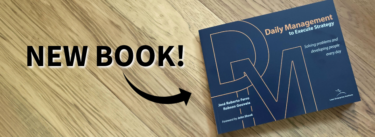I’ve been incredibly fortunate to have traveled and worked globally, deploying Lean in Scandinavia, Brazil, the US, Europe, Southern Africa, as well as the Middle East. I’ve been equally fortunate to have seen most industries within the automotive supply chain from mining minerals to primary raw metal processing to secondary component processing and final assembly at OEM’s of cars and “yellow metal” vehicles. (I’ve yet to see the flipside or re-cycling. I’m sure one day I’ll be afforded that privilege).
All of the above industries have, in principle, various levels of maturity at applying Lean. All have similar management structures, and yet the single biggest hurdle all “new practitioners” have seems to be how to overcome the transition of what they see into an understanding of what needs to be done in order to create value (or extract value from the identified opportunity for value). It’s all well and good knowing the five principles of Lean and the wastes etc., but processing the theoretical understanding into something they can actually do in terms of action is hard at first for anyone.
One of the best routes to doing this is through working with team leaders and supervisors. Why? Because these folks are often a manageable group in most businesses, and when these relationships are managed well, supervisors become the people best positioned to get the message to frontline workers.
A key first step supervisors and team leaders need help with is taking technical conscious observation of the principles of Lean and turning it into a subconscious habitual activity of opportunity identification. By linking habitual lean thinking activities to business performance, supervisors begin to understand their role as way more important than simply “policing” or “supervising.” Their role becomes one that is mission critical and fundamental to business performance.
Just to take a step back for a moment, have you ever asked a group of supervisors or team leaders who have responsibility for a process area or a group of people, what supervision is and how they go about it? You’ll be surprised at the variety of answers you get and what they leading a team to really be about. Answers typically range from the vague to the convoluted and herein lays the problem!
The definition I like to use for Supervision is to “observe and direct the execution of a task.” We can thank the Oxford English Dictionary for this one. Once we understand this definition, it becomes easier to explain what an effective supervisor really does. We might break supervision down into two elements: Telling someone to observe without a framework or terms of reference has little value at all. Telling someone to observe within a “Five M” framework gives them a conscious structure to follow that can then become subconscious with practice.
The Five M Structure:
To explore the Five Ms a little more and the observations, questions, actions of effective supervision, I’ll use a manufacturing scenario to show how the Five Ms can be applied:
- Manpower: Have a look at your team, ask yourself the question: is everyone that is deployed adding value and working towards the days goal? If not, then take actions to re-deploy, re-direct, reduce waste, and motivate resources to focus on the goal and value adding activities.
- Method: Look at how your team is working using equipment. Are they applying a safe working method? Are they using the equipment as trained so as not hurt themselves and cause damage to the product or equipment? Are the methods producing defect free products/components? Could the methods be improved, is there waste, and are the balanced are there any bottle necks?
- Measurement: When learning to observe measurements, are your team on schedule and on takt to achieve the goal output at any given time in the shift? Are rejects zero, is the amount of material being used as expected, are cycle times at standard or better? These are just some of the measurement observation to look for and ask of yourself.
- Materials: Consumption of material and resources: are they correct for what you need to produce? Are indirect materials in place to support the process? Are internal processes in place to ensure supply of raw materials and the removal of finished or part finished goods?
- Machines: Are the machines or equipment being used in such a way to ensure the integrity of the equipment? Are the machines performing as expected, is maintenance being undertaken as planned, are the machines optimal of easy operator use and do not contribute to defects? Is the equipment developing any signs of wear and tear (local areas of noise and hot spots)?
Why Five? Five is a manageable number of process aspects to think about. Some people talk about the 4Ms (without the emphasis on measurement) and yes, we all know there could easily be more.
And let’s talk about the second part of the “supervisor” definition: “direct the execution of a task.” Think of this as the business goal for the shift, production day, or work day. This inevitably comes from the business management team, who should be informing frontline workers accordingly. Effectively trained supervisors (after the right personal development, with the right remit) are able to respond much quickly to sub-standard performance problems and help team members resolve process issues.
So where do you start with your supervisors now that we understand what supervision means? How do you create the habit forming observation skills required?
This skill can be developed in a class room environment (the theory), and then – and this is critical – with mentoring in the workplace. Asking questions with the supervisor while walking his or her area, a trained eye can quickly transfer the skills of observation, questioning, and responses within the framework of the Five Ms. Eventually, supervisors develop the habit of asking the right questions of themselves subconsciously, but even more important, taking the appropriate actions to improve the local performance of the team.
Over time, supervisors who are constantly “observing and directing the execution of a task” become active guides rather than passively filling a supervisory role. In effect, this then translates into a tremendous asset, contributing to your business’s competitive edge.
Business owners, managers, and executives should be motivating excellence at all levels within the organizational structure. Leaving the supervisory level to passively function is as much a crime as leaving your front door regularly unlocked. What do you think is going to happen? Supervisors are really the gate keepers of your direct business activities. They are also your guides when it comes to improvement practices and behaviors.





